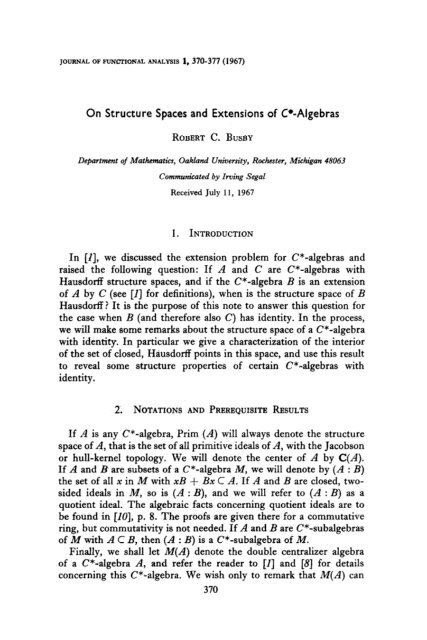On the Characters and the Plancherel Formula of Nilpotent Groups ...
On the Characters and the Plancherel Formula of Nilpotent Groups ...
On the Characters and the Plancherel Formula of Nilpotent Groups ...
You also want an ePaper? Increase the reach of your titles
YUMPU automatically turns print PDFs into web optimized ePapers that Google loves.
JOURNAL OF FUNCTIONAL ANALYSIS 1, 370-377 (1967)<br />
<strong>On</strong> Structure Spaces <strong>and</strong> Extensions <strong>of</strong> C*-Algebras<br />
ROBERT C. BUSBY<br />
Department <strong>of</strong> Ma<strong>the</strong>mutics, Oakl<strong>and</strong> University, Rochester, Michigan 48063<br />
Communicated by Irving Segal<br />
Received July 11, 1967<br />
1. ~TR~DUCTION<br />
In [I], we discussed <strong>the</strong> extension problem for C*-algebras <strong>and</strong><br />
raised <strong>the</strong> following question: If A <strong>and</strong> C are C*-algebras with<br />
HausdorB structure spaces, <strong>and</strong> if <strong>the</strong> C*-algebra B is an extension<br />
<strong>of</strong> A by C (see [I] for definitions), when is <strong>the</strong> structure space <strong>of</strong> B<br />
Hausdorff ? It is <strong>the</strong> purpose <strong>of</strong> this note to answer this question for<br />
<strong>the</strong> case when B (<strong>and</strong> <strong>the</strong>refore also C) has identity. In <strong>the</strong> process,<br />
we will make some remarks about <strong>the</strong> structure space <strong>of</strong> a C*-algebra<br />
with identity. In particular we give a characterization <strong>of</strong> <strong>the</strong> interior<br />
<strong>of</strong> <strong>the</strong> set <strong>of</strong> closed, Hausdorff points in this space, <strong>and</strong> use this result<br />
to reveal some structure properties <strong>of</strong> certain C*-algebras with<br />
identity.<br />
2. NOTATIONS AND PREREQUISITE RESULTS<br />
If A is any C*-algebra, Prim (A) will always denote <strong>the</strong> structure<br />
space <strong>of</strong> A, that is <strong>the</strong> set <strong>of</strong> all primitive ideals <strong>of</strong> A, with <strong>the</strong> Jacobson<br />
or hull-kernel topology. We will denote <strong>the</strong> center <strong>of</strong> A by C(A).<br />
If A <strong>and</strong> B are subsets <strong>of</strong> a C*-algebra M, we will denote by (A : B)<br />
<strong>the</strong> set <strong>of</strong> all x in M with XB + Bx C A. If A <strong>and</strong> B are closed, two-<br />
sided ideals in M, so is (A : B), <strong>and</strong> we will refer to (A : B) as a<br />
quotient ideal. The algebraic facts concerning quotient ideals are to<br />
be found in [IO], p. 8. The pro<strong>of</strong>s are given <strong>the</strong>re for a commutative<br />
ring, but commutativity is not needed. If A <strong>and</strong> B are C*-subalgebras<br />
<strong>of</strong> M with A C B, <strong>the</strong>n (A : B) is a C*-subalgebra <strong>of</strong> M.<br />
Finally, we shall let M(A) d enote <strong>the</strong> double centralizer algebra<br />
<strong>of</strong> a C*-algebra A, <strong>and</strong> refer <strong>the</strong> reader to [I] <strong>and</strong> [S] for details<br />
concerning this C*-algebra. We wish only to remark that M(A) can<br />
370

















